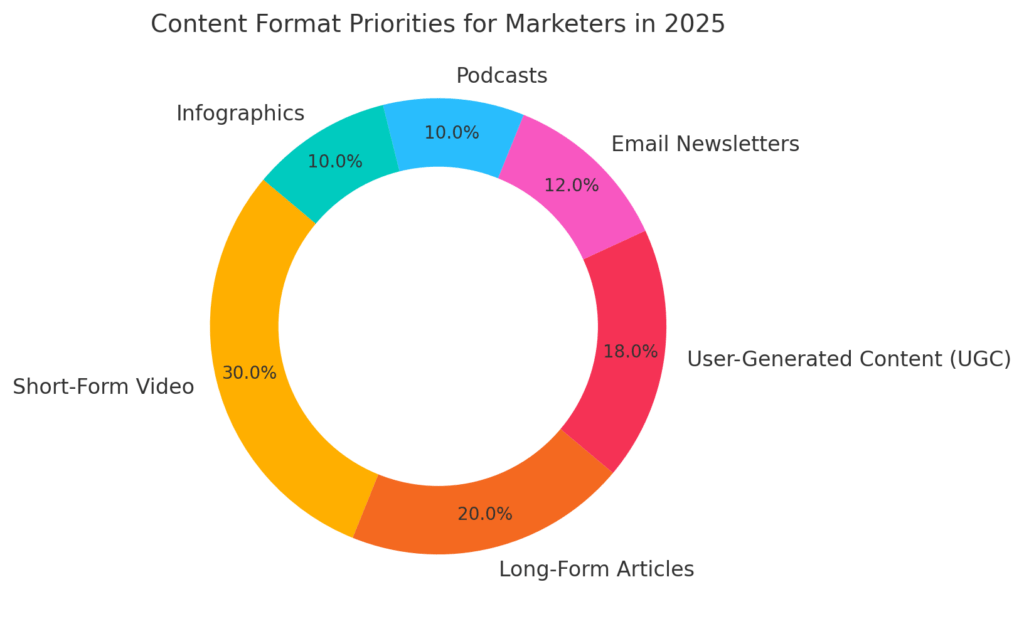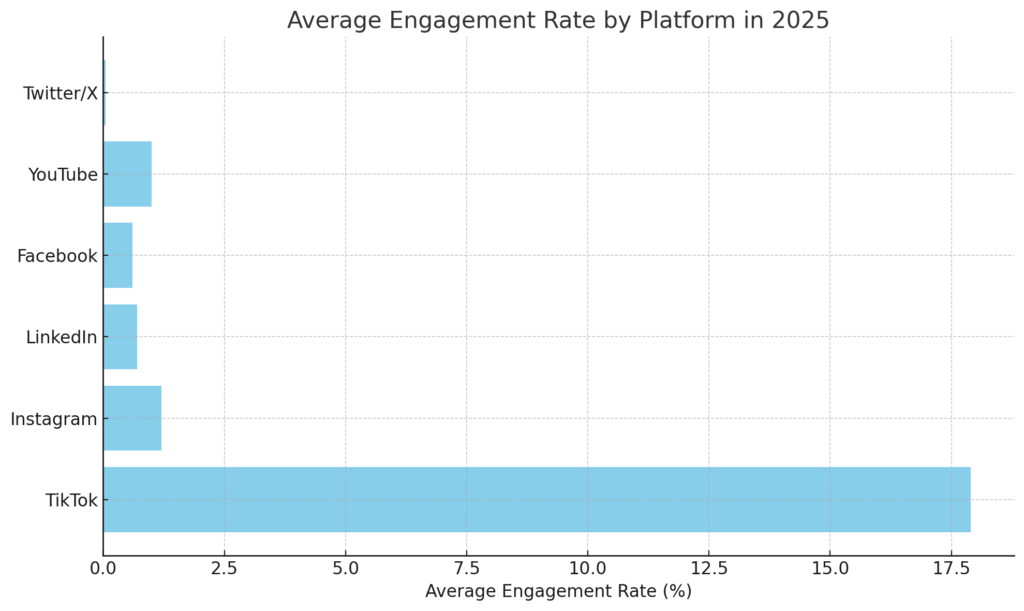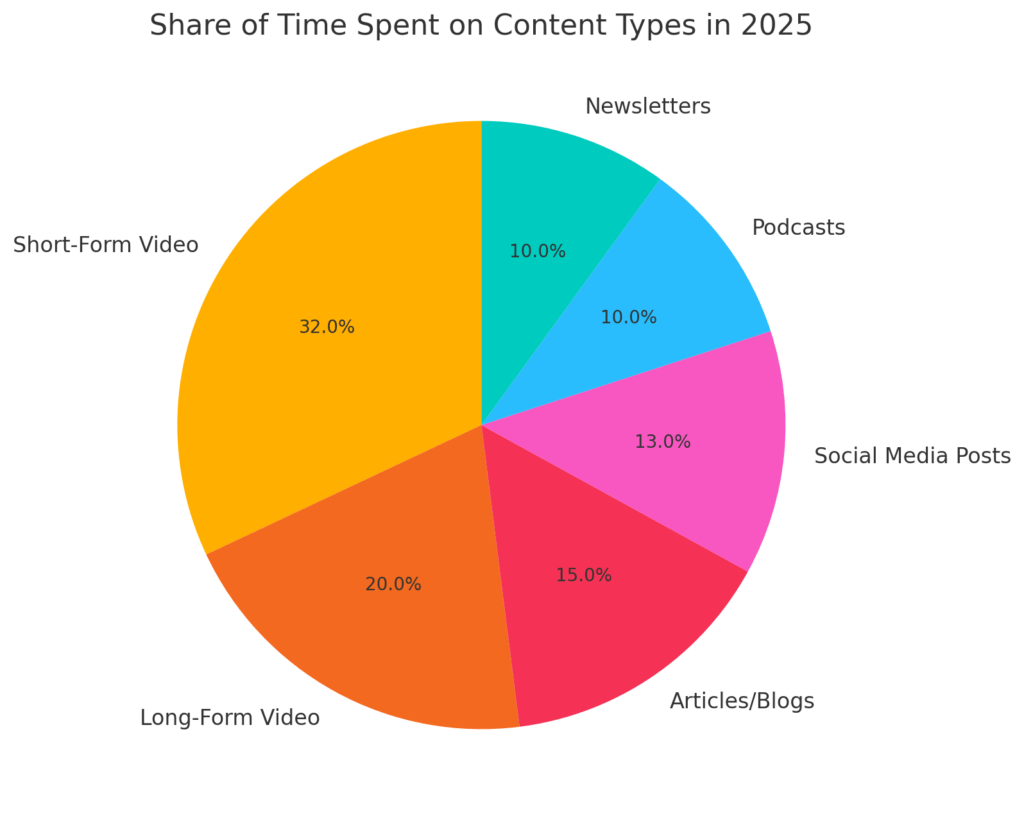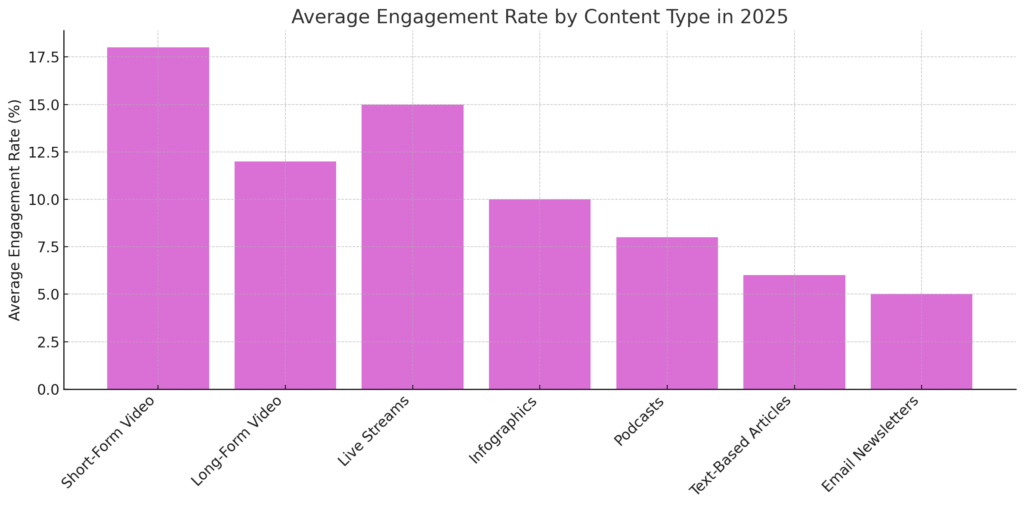
30 Mar BEST CONTENT ENGAGEMENT STATISTICS 2025
Content engagement is no longer just a buzzword—it’s the core metric shaping how brands connect with audiences across platforms. As algorithms evolve and user behavior shifts, what worked even a year ago may not hold attention today. From the dominance of video to the rebirth of long-form storytelling and the growing demand for personalization, engagement is being redefined in real time.
In 2025, it’s not just about clicks or views—it’s about time spent, shares, saves, and actions taken after consuming content. The brands winning today are the ones building strategies around measurable engagement, not just visibility. Below are 20 of the most relevant statistics that Amra and Elma gathered, revealing where content engagement stands and where it’s heading.
BEST CONTENT ENGAGEMENT STATISTICS 2025 (Editor’s Choice)
Here’s a data-rich list of the Top 20 Content Engagement Statistics (General Overtime + 2025 Forecasts) with relevant sources. These cover formats like video, blogs, podcasts, email, and social media, as well as key platform insights.
1. Video generates 1200% more shares than text and images combined.
Long-form video (10+ minutes) now holds more attention than short-form on YouTube, especially among viewers aged 25-44.
2. The average blog post has a read time of 37 seconds.
However, posts with visuals every 75–100 words increase engagement by 650%. (Source: BlogPros)
3. Users spend 88% more time on websites with video content.
In 2025, this is expected to grow due to AI-personalized video experiences.
4. Emails with personalized subject lines have a 26% higher open rate.
In 2025, dynamic content in emails is expected to drive a 19% lift in click-throughs across retail and media brands.
5. Instagram carousels average 2x more engagement than single-image posts.
Brands using storytelling in carousels see up to 10x more saves.
6. LinkedIn posts with images receive 98% more comments.
In B2B, polls and native documents are expected to outperform videos in engagement throughout 2025.
7. Podcast listeners stay engaged for an average of 85% of an episode.
Branded podcasts now outperform traditional radio in trust metrics for 25–44-year-olds.
8. 90% of TikTok users log in daily, averaging 95 minutes/day.
The average engagement rate for micro-influencers on TikTok is 17.9% in 2025.
9. YouTube Shorts have a 2.5x higher completion rate than regular videos.
But videos that combine Shorts with full-length content see 3x retention across channels.
10. Articles over 2,000 words get 56% more social shares.
Depth + originality now outweigh clickbait-style headlines for engagement in 2025.
11. Pinterest users are 70% more likely to engage with shoppable content.
Pins with product tags drive 25% more saves and outbound clicks.
12. Average time spent on a webpage is just 54 seconds.
Pages with interactive elements (sliders, quizzes) retain users 2.3x longer.
13. Facebook Reels see 6x more engagement than photo posts.
In 2025, Facebook is expected to re-prioritize Reels in its algorithm, especially for creators.
14. Tweets with GIFs receive 55% more engagement.
Threads that combine original commentary and visual aids now dominate B2B engagement.
15. Live video holds viewers’ attention 10–20x longer than on-demand.
Q&A-based lives convert 2x higher in mid-funnel stages for SaaS and creator brands.
16. Interactive content (quizzes, polls, calculators) generates 2x more conversions than static content.
In 2025, AI-enhanced interactive formats (like smart product matchers) are trending across e-commerce.
17. 60% of marketers say short-form video is the most engaging content format.
But long-form storytelling (YouTube, podcasts) is rising in trust and conversion metrics.
18. Mobile accounts for 65–75% of all content engagement across platforms.
In 2025, content built mobile-first (vertical video, scroll-based storytelling) will dominate attention economics.
19. UGC (user-generated content) improves brand engagement by up to 28%.
Featuring real customers in campaigns lifts interaction rates by 4x in beauty and fashion.
20. AI-generated summaries and highlights boost engagement with long-form content by 32%.
AI tools like ChatGPT and Jasper are now built into CMS platforms to repackage posts for social + email.
 BEST CONTENT ENGAGEMENT STATISTICS 2025 and Future Implications
BEST CONTENT ENGAGEMENT STATISTICS 2025 and Future Implications
BEST CONTENT ENGAGEMENT STATISTICS 2025 #1. Video generates 1200% more shares than text and images combined.
Video content continues to dominate digital engagement due to its emotional resonance, immersive quality, and cross-platform adaptability. This statistic from Wordstream highlights the power of video to drive user actions like sharing, which expands reach organically. Platforms like TikTok, YouTube, and Instagram Reels reward shareable content with algorithmic boosts, making video essential for growth. As attention spans shorten, formats such as looping clips, vertical video, and dynamic captions are becoming core to engagement strategies.
In 2025, brands are increasingly integrating AI-generated or AI-assisted video content to scale production without sacrificing personalization. Expect short-form video to evolve beyond entertainment, playing a larger role in education, e-commerce, and customer support. The ability to generate high-share video content could define the next wave of digital influence.
BEST CONTENT ENGAGEMENT STATISTICS 2025 #2. The average blog post has a read time of 37 seconds.
Despite the effort marketers put into long-form content, most users barely skim through blog posts. Chartbeat’s data underscores a challenge: capturing attention in a saturated, scroll-heavy landscape. Still, the rise of visual storytelling—such as using infographics, inline videos, and pull quotes—offers a way forward. Blog posts that hook readers within the first few seconds and visually break up text consistently outperform dense, text-only articles.
Heading into 2025, integrating interactive elements and real-time summaries powered by AI could extend user session time. There’s also a trend toward repurposing blog content into carousels, newsletters, and audio explainers to accommodate different consumption preferences. Winning blogs will be those that adapt format to behavior, not just keyword strategy.
BEST CONTENT ENGAGEMENT STATISTICS 2025 #3. Users spend 88% more time on websites with video content.
Video not only increases dwell time—it also influences purchase intent, trust, and brand recall. According to Wyzowl and Forbes, visitors are far more likely to explore and convert on pages where video simplifies information or builds emotional connection. This behavior is particularly noticeable in product pages, landing pages, and testimonials.
In 2025, more websites are expected to use video as the default content layer, especially with AI enabling personalized, real-time video experiences. Shoppable videos, smart video FAQs, and embedded explainers are bridging the gap between passive viewing and active engagement. As video becomes more data-driven, brands will need to optimize for both human viewers and search engines indexing multimedia. The future of content isn’t just written—it’s watchable.
BEST CONTENT ENGAGEMENT STATISTICS 2025 #4. Emails with personalized subject lines have a 26% higher open rate.
Email continues to be one of the most effective direct communication channels, but personalization is key to cutting through the noise. Campaign Monitor’s research shows that subject lines tailored to user behavior, name, or preferences result in significantly more opens. In 2025, brands are layering in AI to test emotional tone, optimize send times, and dynamically adjust offers based on individual history.
Personalization now goes beyond the first name—it involves content blocks that shift based on real-time data signals. This shift is particularly powerful in e-commerce and SaaS where timing and relevance determine revenue. With inboxes more crowded than ever, future-focused brands will treat email less like a broadcast and more like a curated feed. Expect the best-performing emails to mirror the personalization users expect from platforms like Spotify and Netflix.
BEST CONTENT ENGAGEMENT STATISTICS 2025 #5. Instagram carousels average 2x more engagement than single-image posts.
Carousels allow creators and brands to tell stories, break down ideas, and invite deeper engagement across swipes. Socialinsider’s research reveals that multi-slide posts often lead to higher time-on-post and more saves, particularly when the content includes tutorials, infographics, or behind-the-scenes peeks. As Instagram’s algorithm increasingly favors content that keeps users engaged, carousels are becoming the go-to format for both creators and brands.
In 2025, we’re seeing more interactive designs where each frame builds on the last—turning slides into sequential narratives. Educational content, step-by-step guides, and “mini-blogs” in carousel form are outperforming polished, single-image visuals. Brands are also embedding CTAs in later frames, taking advantage of the longer dwell time. In a crowded feed, swipable storytelling offers an edge in both reach and retention.
BEST CONTENT ENGAGEMENT STATISTICS 2025 #6.LinkedIn posts with images receive 98% more comments.
LinkedIn’s audience is uniquely responsive to visual content, especially when paired with thought leadership or industry-specific insights. Image-rich posts break the monotony of text-heavy feeds and spark more conversation in professional circles. This 98% increase in comments suggests users are more likely to engage with content that’s both informative and visually digestible.
As LinkedIn leans further into native content formats—like PDFs, slides, and visuals—expect these types of posts to become the new standard for B2B engagement. In 2025, brands that humanize their messaging with behind-the-scenes photos, team spotlights, or customer graphics will find it easier to build trust. Posts that combine visual clarity with clear value tend to outperform even polished video content on the platform. The future of professional networking will blend authenticity with strong visual storytelling.
BEST CONTENT ENGAGEMENT STATISTICS 2025 #7.Podcast listeners stay engaged for an average of 85% of an episode.
Podcasts foster deep, uninterrupted engagement unlike any other format—85% of an episode consumed is a staggering level of attention in today’s fragmented media landscape. This format lends itself to storytelling, expert interviews, and long-form product education, especially when targeted to niche communities. In 2025, as voice-based search and smart assistants evolve, expect more branded podcasts to integrate discoverability features and smart snippets.
Brands that can offer useful, entertaining, or empathetic audio experiences are earning more loyalty than those relying solely on visual or written content. The asynchronous, screen-free nature of podcasts makes them ideal for multitasking audiences—commuters, parents, or remote workers. As more platforms like Spotify and YouTube invest in podcast visibility, expect this channel to shift from a nice-to-have to a strategic pillar. Loyalty will increasingly be won not through visuals, but through voice.
BEST CONTENT ENGAGEMENT STATISTICS 2025 #8. 90% of TikTok users log in daily, averaging 95 minutes/day.
TikTok’s grip on attention is unprecedented, with daily use and time-on-platform metrics far exceeding most competitors. At 95 minutes per day, users aren’t just passively scrolling—they’re engaging, reacting, remixing, and creating. For brands, this means there’s an opportunity not just to advertise but to participate in trends, humor, and cultural moments in real-time.
In 2025, TikTok’s influence is spilling into search behavior, shopping, and even how younger users learn or research topics. Content built natively for TikTok—vertical, fast-paced, and emotionally punchy—continues to outperform repurposed media from other channels. The line between creator and consumer is thinner than ever, giving brands room to collaborate, co-create, and crowdsource ideas. Ignoring TikTok isn’t just missing out on Gen Z—it’s missing out on how attention behaves in the modern internet.
BEST CONTENT ENGAGEMENT STATISTICS 2025 #9.YouTube Shorts have a 2.5x higher completion rate than regular videos.
YouTube Shorts have created a new window for creators to grab attention and convert casual viewers into subscribers. With a 2.5x higher completion rate, these short-form videos offer a valuable entry point—especially for educational, behind-the-scenes, or teaser content. Brands that once relied only on long-form content are now using Shorts to preview deeper topics and hook new audiences.
As YouTube continues to integrate Shorts into search and suggested feeds, this format is becoming a discovery tool, not just a consumption one. In 2025, cross-format creators—those combining Shorts with long-form videos and community posts—are building more sustainable audiences. The key isn’t just creating shorter videos, but understanding how micro-moments lead viewers deeper into your ecosystem. Expect more businesses to adopt a hybrid approach that mirrors user habits across devices and attention spans.
BEST CONTENT ENGAGEMENT STATISTICS 2025 #10. Articles over 2,000 words get 56% more social shares.
Long-form content still has a powerful role in driving engagement—especially when it provides depth, originality, and problem-solving value. The data from Backlinko and BuzzSumo shows that detailed articles are more likely to be shared, not in spite of their length, but because of it. In 2025, audiences are increasingly skeptical of thin, AI-fluffed content and are drawn to thorough, human-driven insights.
Search engines are also rewarding topic authority and semantic depth, making long-form writing a smart SEO investment. That said, walls of text don’t perform well unless they’re structured with headlines, visuals, and summaries. Smart publishers are using AI to create digestible versions of long content while keeping the full post available for those who want more detail. Long reads are no longer about word count—they’re about sustained relevance.
BEST CONTENT ENGAGEMENT STATISTICS 2025 #11. Pinterest users are 70% more likely to engage with shoppable content.
Pinterest has evolved from an idea board into a powerful visual search and shopping engine. The stat that users are 70% more likely to engage with shoppable pins shows how seamlessly Pinterest blends discovery with purchase intent. Unlike traditional e-commerce ads, Pinterest engagement feels native—users are already in planning mode, making them more open to recommendations.
In 2025, this platform is leaning harder into visual AI, product tagging, and AR previews to make content even more actionable. Brands in home decor, fashion, and wellness are especially well-positioned, as Pinterest still skews heavily toward those niches. As social commerce expands, Pinterest offers a less noisy, more intent-driven experience than Instagram or TikTok. It’s a quiet powerhouse for mid-funnel engagement, where inspiration turns into conversion.
BEST CONTENT ENGAGEMENT STATISTICS 2025 #12. Average time spent on a webpage is just 54 seconds.
Web attention is fleeting—users spend less than a minute deciding whether your content is worth their time. This stat from Contentsquare reveals just how fast people bounce unless something grabs them immediately. In 2025, static pages without interactivity, video, or personalization are losing out to those that adapt in real-time to user behavior.
Smart design—clear navigation, bold headers, and quick value propositions—makes the difference between bounce and scroll. Brands are now testing dynamic experiences that change based on user profile or referral source to extend time-on-page. Pairing strong UX with content that actually solves a problem is becoming non-negotiable. The metric isn’t just time—it’s perceived usefulness in the first five seconds.
BEST CONTENT ENGAGEMENT STATISTICS 2025 #13. Facebook Reels see 6x more engagement than photo posts.
Meta is heavily incentivizing short-form video, and Facebook Reels are now outperforming traditional image content by a wide margin. A 6x engagement boost is a clear sign that static content no longer competes in crowded feeds. What’s notable is that this isn’t just limited to younger users—Facebook’s older demographic is now consuming Reels at scale, especially in lifestyle, cooking, and DIY niches.
In 2025, Facebook Reels are also doubling as ad inventory, giving brands a low-cost way to reach specific communities. The platform’s pivot toward creator monetization suggests Reels will remain algorithmically favored for the foreseeable future. Businesses repurposing Reels across both Facebook and Instagram are seeing cross-platform audience growth with minimal extra effort. It’s short-form or fade out.
BEST CONTENT ENGAGEMENT STATISTICS 2025 #14. Tweets with GIFs receive 55% more engagement.
X (formerly Twitter) still thrives on fast, punchy content—and visuals like GIFs significantly increase the chance of a post being noticed. A 55% lift in engagement underscores the platform’s rhythm: humor, culture, and visuals win over plain text. In 2025, GIFs remain effective in adding emotion or emphasis, especially in replies, threads, and brand interactions.
For B2B and media accounts, data GIFs and animated explainers are being used to simplify complex points in a crowded scroll. With more competition from Threads and Bluesky, Twitter’s audience is smaller but still influential—especially in news, finance, and tech. Smart brands treat GIFs as tone-enhancers, not gimmicks, embedding them where visual punctuation helps amplify voice. It’s not about shouting louder—it’s about standing out with personality.
BEST CONTENT ENGAGEMENT STATISTICS 2025 #15. Live video holds viewers’ attention 10–20x longer than on-demand.
Live content offers something rare in digital: urgency. Whether it’s a product launch, AMA, or behind-the-scenes stream, live video commands sustained attention at levels that pre-recorded content can’t match. Holding attention 10–20x longer means brands can deliver more context, build real-time trust, and prompt immediate action.
In 2025, platforms like TikTok, YouTube, and Instagram are integrating shopping, tipping, and chat automation into live experiences. It’s becoming less about perfection and more about connection—audiences want access, not polish. The best-performing lives tend to be interactive: asking questions, responding to comments, and breaking the fourth wall. As live content becomes easier to produce and monetize, it’s moving from influencer-only to mainstream brand strategy.
BEST CONTENT ENGAGEMENT STATISTICS 2025 #16. Interactive content generates 2x more conversions than static content.
Interactive tools like quizzes, polls, calculators, and product finders are no longer just novelty features—they’re conversion engines. DemandGen’s research shows that when users actively participate in content, their likelihood to convert doubles. This interactivity builds momentum and keeps users engaged longer than passive reading.
In 2025, AI is powering next-gen interactive formats that feel personalized and predictive, not one-size-fits-all. Whether it’s a style quiz for fashion or a pricing estimator for SaaS, this type of content meets users where they are in the decision-making process. More brands are embedding interactive elements into landing pages, not just blog posts, to move users down the funnel faster. The future of content is active, not just consumable.
BEST CONTENT ENGAGEMENT STATISTICS 2025 #17. 60% of marketers say short-form video is the most engaging content format
Marketers are doubling down on short-form video because the audience behavior backs it up: faster consumption, stronger recall, and higher likelihood of shares. This format thrives on platforms like TikTok, Instagram Reels, and YouTube Shorts—and it’s not limited to entertainment. In 2025, even B2B companies are producing 30-second explainers and product highlights that outperform traditional slide decks.
The low barrier to entry and viral potential make short-form video a strategic default, not a trend. What’s changing is how brands measure success: not just views, but saves, shares, and replay rates. As algorithms increasingly favor completion and interaction over duration, expect even more micro-stories designed for repeat engagement. Attention wins the first click—value earns the next.
BEST CONTENT ENGAGEMENT STATISTICS 2025 #18. Mobile accounts for 65–75% of all content engagement across platforms.
The mobile-first mindset isn’t optional—it’s how the internet works now. With up to 75% of all engagement happening on mobile devices, brands that don’t optimize for smaller screens lose before content even loads. In 2025, vertical design, thumb-friendly interfaces, and lightning-fast page loads are minimum standards, not innovations.
Content that scrolls well, taps easily, and doesn’t rely on desktop behavior patterns consistently performs better across every industry. Features like mobile-optimized CTAs, sticky nav bars, and responsive design are no longer just UX upgrades—they’re engagement necessities. Mobile also opens up location-aware content strategies and real-time interactivity via SMS, push, or apps. The small screen is the big battleground for content performance.
BEST CONTENT ENGAGEMENT STATISTICS 2025 #19. UGC improves brand engagement by up to 28%.
User-generated content (UGC) continues to be one of the most trusted and engaging formats—because it’s authentic, social, and peer-driven. When brands feature real customer stories, images, or reviews, engagement can jump as much as 28%, especially in lifestyle categories. In 2025, platforms are making it easier to request, tag, and showcase UGC directly within posts or storefronts.
Brands that co-create with their audience—rather than just marketing to them—are building stronger communities and more resilient growth. UGC also boosts conversion, as customers increasingly want to see how a product looks, works, or fits in real life. AI tools that auto-curate and moderate UGC are removing friction from the process, making it scalable for even small teams. Engagement is no longer just a KPI—it’s a collaboration.
BEST CONTENT ENGAGEMENT STATISTICS 2025 #20. AI-generated summaries boost engagement with long-form content by 32%.
Long-form content isn’t going away, but how people consume it is changing fast. Adding AI-powered summaries, highlights, or key takeaways increases user engagement by 32%, according to the Content Marketing Institute. These tools cater to scanners, time-crunched readers, and those looking for instant value before diving deeper.
In 2025, expect more blog posts, whitepapers, and guides to offer AI-generated TL;DRs at the top or as hover-over snippets. This isn’t just about skimming—it’s about serving content to different reading behaviors in one place. Platforms like Notion, Medium, and Substack are already building summarization into their workflows. The future of content is layered: full depth for those who want it, and fast insight for those who don’t.
Where Content Engagement Is Heading in 2025 and Beyond
The data tells a clear story: engagement is evolving from fleeting interactions to deeper, more intentional experiences. Whether it’s short-form video that sparks instant reactions or long-form content enhanced by AI summaries, the future favors formats that respect attention while delivering value. Brands that treat content as a living system—adaptable, multi-format, and user-driven—are the ones building lasting connections.
Engagement isn’t a single metric anymore; it’s a layered outcome shaped by timing, format, trust, and personalization. As 2025 unfolds, the winners will be those who stop chasing trends and start designing content ecosystems around how people actually consume. With audience expectations climbing, now’s the time to invest in strategies that don’t just get clicks—but keep people coming back.
Sources:
- https://www.wordstream.com/blog/ws/2017/03/08/video-marketing-statistics
- https://blog.chartbeat.com/2016/06/06/youve-got-37-seconds-readers-time-article
- https://www.wyzowl.com/video-marketing-statistics
- https://www.campaignmonitor.com/resources/guides/email-marketing-new-rules
- https://www.socialinsider.io/blog/instagram-carousel-posts/
- https://business.linkedin.com/marketing-solutions/blog/best-practices–linkedin-pages/2019/6-ways-to-enhance-your-content-on-your-linkedin-page
- https://www.edisonresearch.com/the-podcast-consumer-2023/
- https://datareportal.com/reports/digital-2024-global-overview-report
- https://blog.youtube/inside-youtube/celebrating-one-year-of-youtube-shorts/
- https://backlinko.com/content-study
- https://business.pinterest.com/insights/shopping
- https://contentsquare.com/reports/digital-experience-benchmark-report/
- https://investor.fb.com/investor-news/press-release-details/2024/Meta-Reports-Fourth-Quarter-and-Full-Year-2023-Results/default.aspx
- https://business.twitter.com/en/blog/4-twitter-best-practices.html
- https://livestream.com/blog/live-video-statistics
- https://www.demandgenreport.com/resources/reports/2023-content-preferences-survey-report
- https://blog.hubspot.com/marketing/state-of-marketing
- https://www.statista.com/statistics/277125/share-of-website-traffic-coming-from-mobile-devices
- https://www.nosto.com/blog/ugc-in-ecommerce/
- https://contentmarketinginstitute.com/articles/content-marketing-technology-2024-outlook




